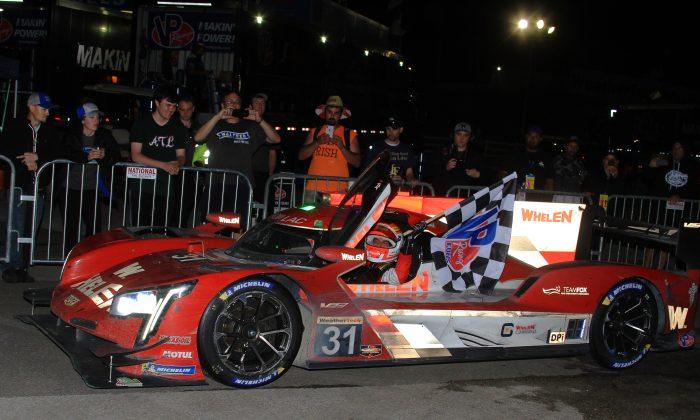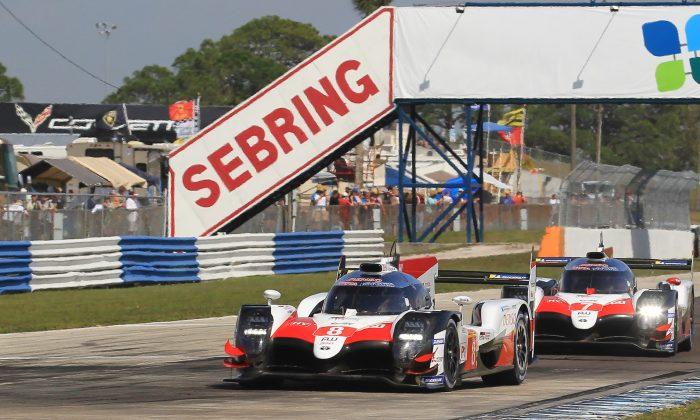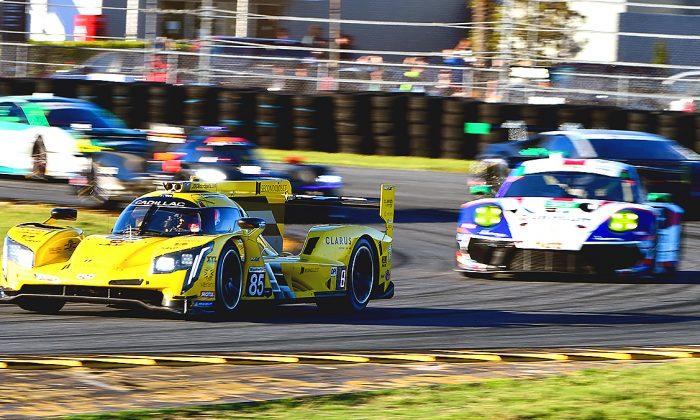Pipo Derani, Johannes van Overbeek, and Nicolas Lapierre brought the #22 Tequila Patron Extreme Speed Motorsports Nissan DPi across the finish line 12 seconds ahead of the nearest competitor after 12 hours of racing at the toughest road track in the world.
The #22 ESM was quick all day. It ran flawlessly, and the drivers kept it out of trouble—no offs, no collisions, not even a broken dive plane.

Lapierre showed how it worked when he made a move to take the lead just around sunset. The ESM driver cut inside Mike Conway in the leading #31 Whelen Cadillac. Conway went strong around the outside—they pair went side-by-side through Turn One and all the way to Turn Three. Conway moved across entering Two and Lapierre let him go. He was still in second place—and he wasn’t in the wall. That kind of presence of mind is what led to the ESM car winning.
By contrast, Olivier Pla in the sister car, the #2 Nissan, got into a collision with Tristan Vautier in the pole-sitting #90 Spirit of Daytona Cadillac DPi in the first corner on the first lap. The ESM car made it the first few hundred yards, had contact, and went right to the garage and was done for the race.

Porsche took its 71st class win at Sebring, beating BMW in the GT Le Mans class. The #911 Porsche of Patrick Pilet, Nick Tandy and Frédéric Makowiecki finished six seconds ahead of the #25 BMW M8 GTLM of Bill Auberlen, and Connor De Phillippi, and Alexander Sims—and did it despite having the Porsche’s rear valence and diffuser torn off in contact just after the eight-hour mark.

Lamborghini won its second IMSA endurance race of the company’s history and took its first Sebring win, when Madison Snow, Bryan Sellers, and Corey Lewis brought the Paul Miller Racing Lamborghini Huracan GT3 across the line eight seconds ahead of the #63 Scuderia Corsa Ferrari 488 GT3 driven by Gunnar Jeannette, Cooper MacNeil, and Alessandro Balzan.

With 18 entries, the GTD field was almost as big as the other two combined, and there was almost twice as much action. The three-way fight between the Paul Miller Lambo, the Scuderia Corsa Ferrari, and the #33 Mercedes-AMG Team Riley AMG GT3 of Ben Keating, Luca Stolz, and Jeroen Bleekemolen kept the excitement level high right to the finish.

All three classes were close. After 12 hours of racing, the combined margin of victory was 26.826 seconds—an average gap of 8.942 seconds. The winning cars each gained on average 0.745166667 seconds per hour. That is close competition.

There are two components a team needs to win an endurance race: The need to be fast, and they need to be last.
The “fast” part is obvious. Finish first to win—the winner has t get to the finish line first.
But to be first, the team has to finish. The car has to survive hours of high-speed driving.
On some tracks this might be speeds well of 200 mph, or loads of up to five Gs, or bumps and cracks in the pavement, while the engine has to run as hard as it can go, for hours at a time.

The drivers have to perform almost perfectly over several stints behind the wheel, some of which might last an hour, some three or more.
The drivers, after hours of being bounced and battered by high g-forces, have to maneuver through packs of cars, all very near their limits of performance, and make split-second, life-or-death decision—many times a lap, for hours at a time.

And the crew has to last. The crew arrives first, unloads, and starts preparing the car hours before the first practice session. They have to constantly adjust the car during the practice sessions, and during the race.

The crew has to work with brakes, engine, exhaust, turbochargers sometimes, which heat up to several hundred to over one thousand degrees—and has to work on a racetrack, in tight quarters, at maximum speed, and without error.
Add to that the nature of Sebring International Raceway—3.74 miles of broken, pitted, asphalt and concrete, some of it 80 years old. Driving at Sebring is like riding over an endless series of speed bumps with the occasional curb thrown in—as fast as possible for twelve hours non-stop.

Sebring is where teams wanting to win 24-hour races would come to test—any car which could survive 12 hours at Sebring could easily survive 24 at any other track in the world. There is simply no track anywhere on the planet which beats a car and driver like Sebring. Not hyperbole—fact.
Winning at Sebring is tough—not just difficult, but tough. The car, drivers, and crew have to be tough. The suspension will get beat like an off-road racer’s, the chassis will get hammered as if it were in a series of collisions, and the driver will get battered as if he or she was in a can full of ball bearings in a paint-shaker.

Any team which wins the Sebring 12 Hours deserves respect.
So, what can one say about Extreme Speed Motorsports, which just won Sebring a second time in three years?
No need to say anything. They know what they have done—and so does every fan, and every other team.

In 2017, the team switched to an Onroak-built Nissan powered Daytona prototype International, (DPi) and they struggled a bit, developing the brand-new platform and power plant.
ESM started 2018 with a disappointing showing at Daytona, finishing 48th out of 50, but they came to Sebring ready to rock.

No one, it seems, has figured out how to stop Pipo Derani when he gets behind the wheel at Sebring. He won the 2016 12 hours with a pair of bravura passes on the outside at Turn 7, and by being faster. Just faster. As fast as he needed to be, even if that seemed impossible. He just did it.
Luís Felipe “Pipo” Derani is no longer the “young phenom” he was in 2016, when no one had heard of him and everyone was shocked as he piloted the ESM car to overall wins at both the Rolex 24 at Daytona and the 12 Hours.

He did it again at Sebring this year, though he wasn’t tested in a different way. He was as fast as he needed to be—but he won this year not by going fast, but by being efficient.
The final stint was about stretching a tank a fuel all the way to the end—while still maintaining a cushion on the competition.
It was a near thing. The low-fuel warning lit up the #22 ESM Nissan’s dashboard on the final lap, but Derani brought it home ahead of everyone else.
“The pit was every lap telling me the gap, and I was trying to save fuel at maximum as I could, and in the end was really, really tight,” Derani told Fox Sports racing reporter Jamie Howe.
“We got the “low fuel” on the last lap but we finally made it, I can’t believe it.”
Not only did Derani stretch the fuel—he doubled the six-second gap he inherited when he got into the car. Like multiple IndyCar champ Scott Dixon, Pipo Derani is one of those rare talents who can go fast and still save fuel.

The Taylor brothers split up this season, with Ricky moving over to the new Penske Acura team and Jordan staying with his father’s team. His co-drivers, Renger Van Der Zande, and Indy 500 winner Ryan Hunter-Reay, certainly brought enough talent and experience to the team.
The #10 Taylor Racing Cadillac DPi lost some time early in the day with overheating issues—but were able to stay in the top five most of the time.

At Sebring, teams endure the day and win or lose once the sun sets. The #10 WTR was strong in the evening hours … but the #22 ESM was as good a car, and had a gap which no other team could close.

2016 season champions Whelen Engineering finished third, 40 seconds behind the WTR entry and 53 behind Pipo Derani in the ESM. Another team which looked unimpressive in practice and qualifying but brought their “A” game to the final hours. Drivers Felipe Nasr, Eric Curran, and Mike Conway finished strong … but … Pipo Derani.

The #31 Cadillac DPi moved into the lead in the second hour, and ran in the top three in the daylight hours—but the Cadillac seems to have lost the torque advantage which made winning ride in just about every other WeatherTech race since the DPi class was introduced.

Another part of winning at Sebring is keeping the car clean. ESM driver Johannes van Overbeek pointed out that the car, sitting there in victory circle, didn’t have a scratch on it.
The #10 and the #31 actually came together with about four-and-a-half hours left, tearing bodywork off the #10. There were enough cautions late in the race that the #10 was able to make up lost time, but the cars get beat up enough without adding to it.

Honorable mention to the Core Autosports crew. The team, which stepped up to the Prototype ranks this season with an Oreca-Gibson, finished fourth and won the Pro-Am competition. Drivers Romain Dumas, Colin Braun, and owner/driver Jonathan Bennett showed that their experience winning multiple LMPC titles moved up with them when they headed to the top class.

Whichever cosmic force which Mazda Racing has angered, the team would be well advised to make proper reparations.
Management of the team was taken over by Joest Racing this year, and everyone expected the kind of results the team has almost delivered since it joined the Prototype ranks 2007.
Every year Mazda seems to make great strides—and also seems to find some new way to not quite succeed. (Bursting into flames has been the failure mode of choice so often “Mazda barbeque” has become a running joke.) That happened at the 2018 Rolex 24, leaving people wondering what could possibly save the team, if even a full off-season’s redesign by the Joest squad couldn’t keep the cars running.

A team of fiction writers couldn’t come up with as many horror-story plots as Mazda has struggled through since entering the Prototype class. And sadly, Sebring 2018 was one of the most horrible endings to date.

Mazda brought a pair of quick cars to Sebring—the pair finished fasted in the last daytime practice session.
The cars qualified 7th and 9th, but were relegated to the back of the Prototype grid for taping the body seams—a normal practice for Joest in the series it usually runs, abut illegal in IMSA. Even so, in a 12-hour race, starting position doesn’t much matter.

Mazda brought two Riley Mk. 30-based DPis, the #55 and the #77. The #77 lost laps during the day with mechanical issues, but the #55 ran strong—and in the closing hours, was running up front.
That’s right folks—the #77 Mazda was in first place, on pace, intermittently, from about the seven-hour mark, and was in the top three for much of the final four hours.
The Mazdas have the smallest engine of all the prototypes, but they also have an efficient engine, it turns out, and with 45 minutes to go, it seemed that Harry Tincknell, running second, could possibly take the lead by virtue of needing less fuel at the final pit stop.
Tincknell pitted, the team filled the tank … and the car refused to restart.
The #77 Mazda DPi had been suffering clutch problems for several hours, but the team is allowed to push-start it, and the problem didn’t cost any time.
This time, everything went wrong. The car simply refused to fire up. The crew pushed it as far down the track as the rules allowed …. And when it didn’t fire up, they had to push it back and try again.
And as an Added Attraction .....
A few more photos from veteran Motorsports photographer Bill Kent.










